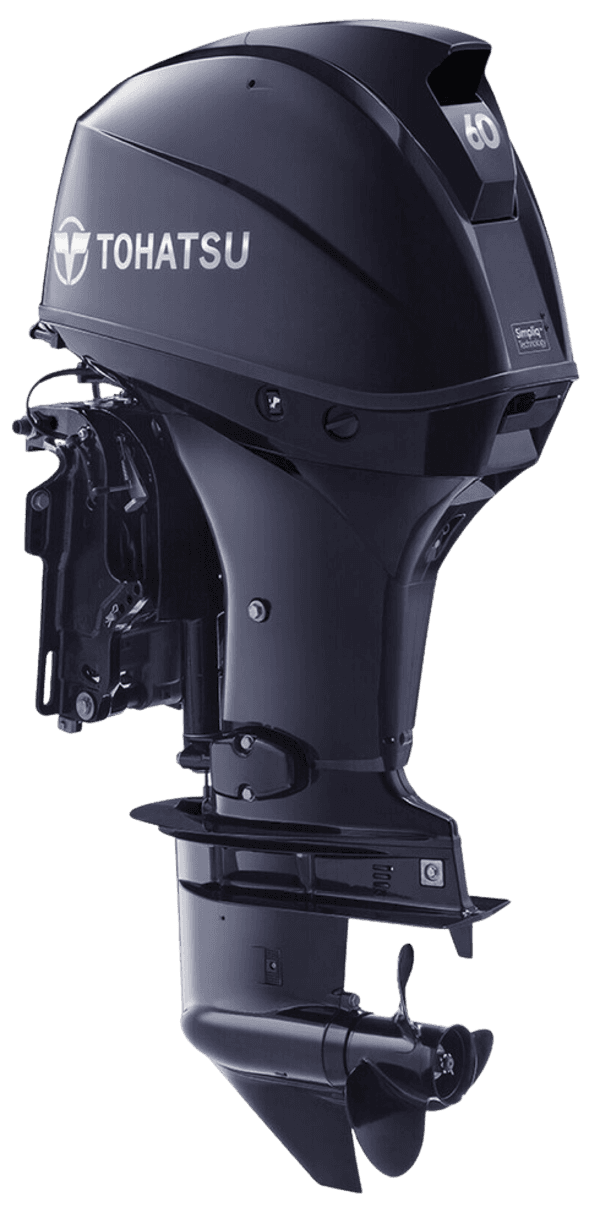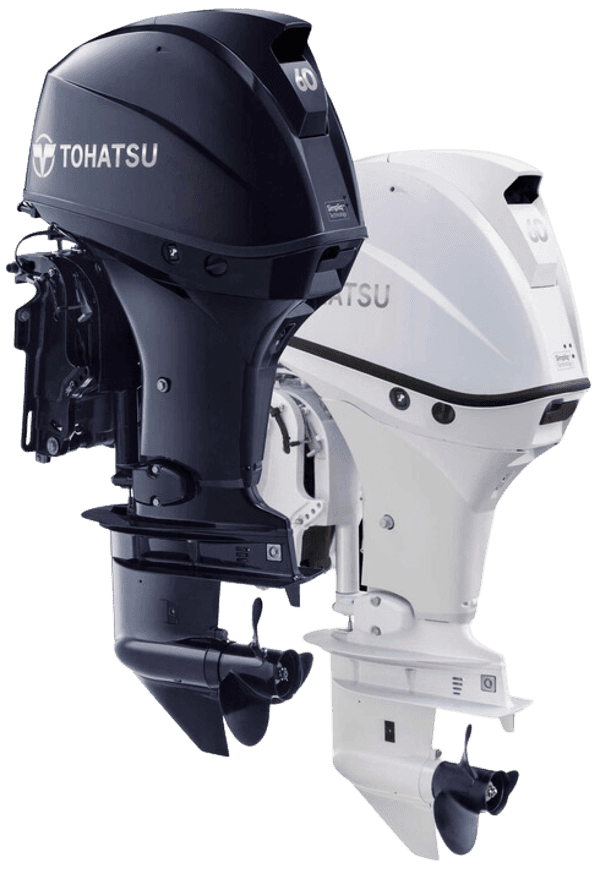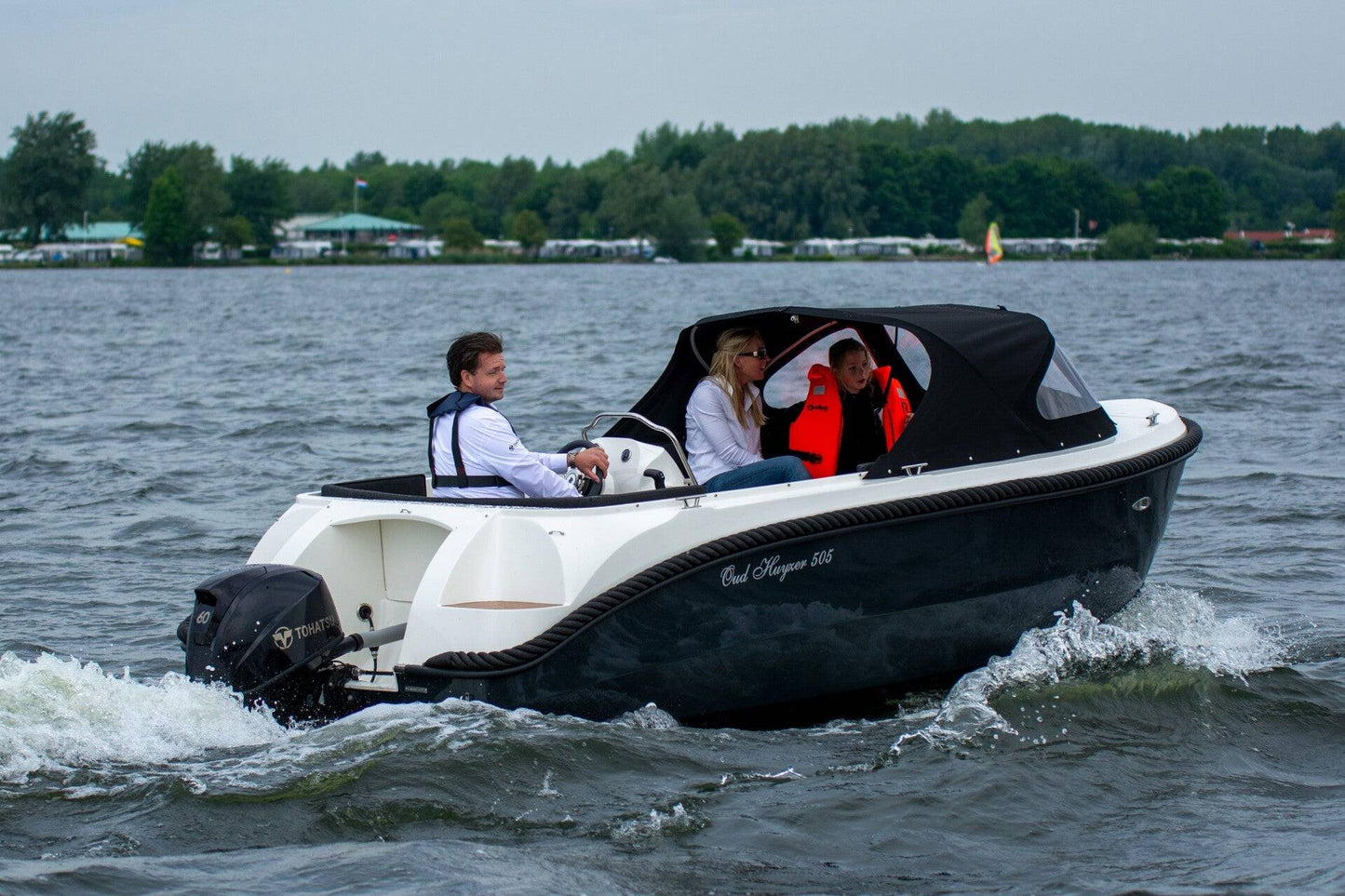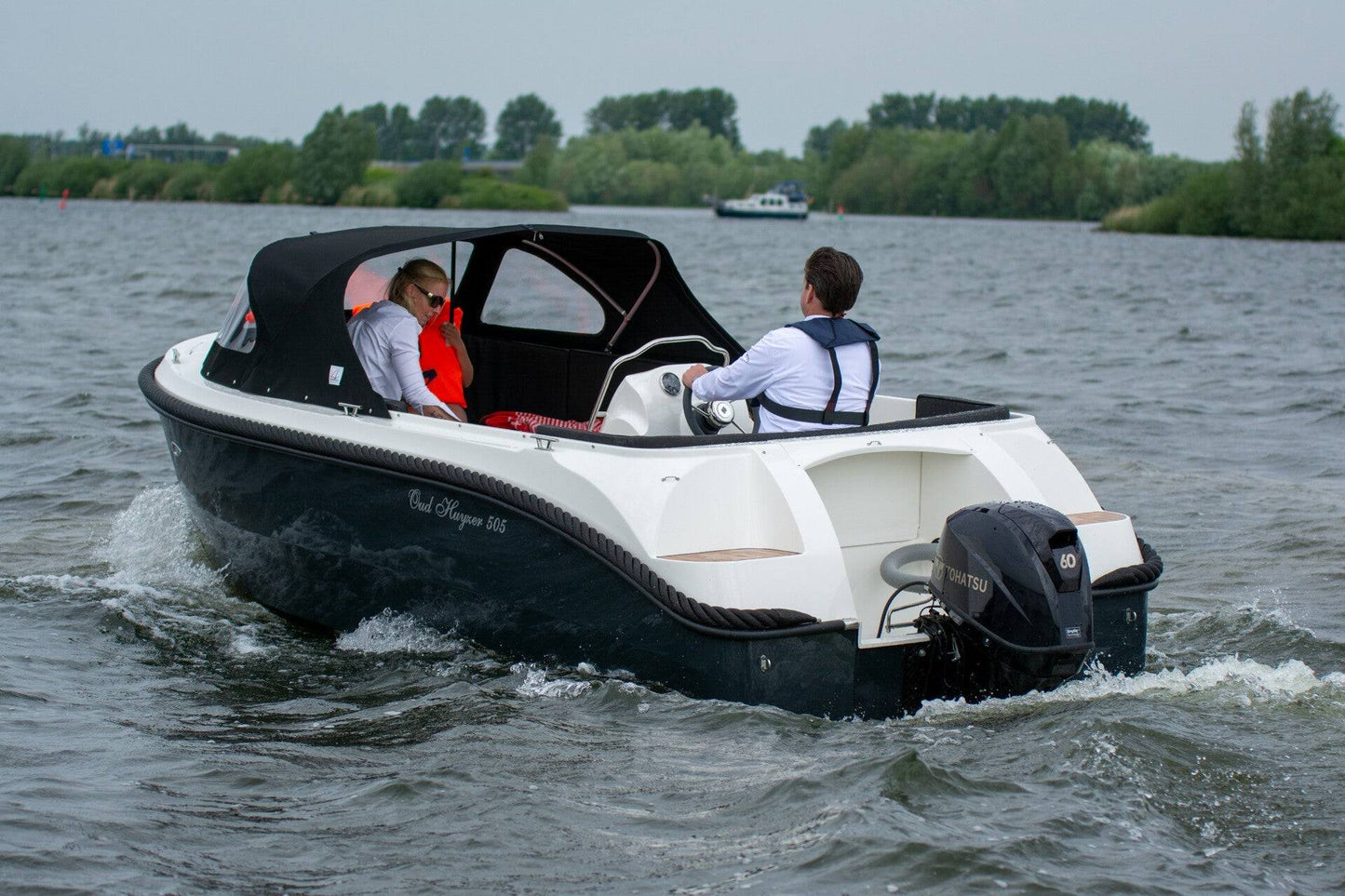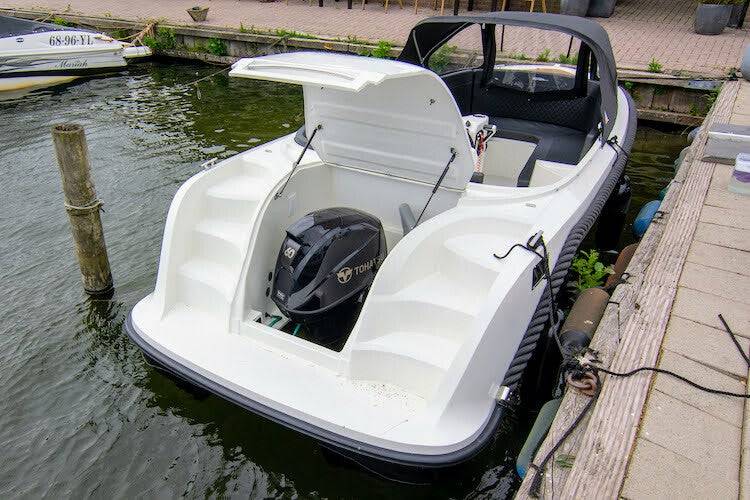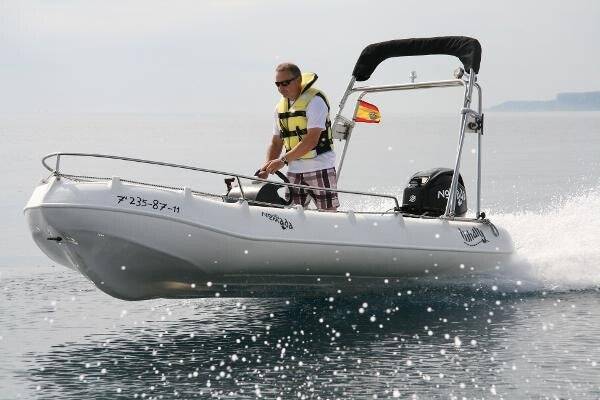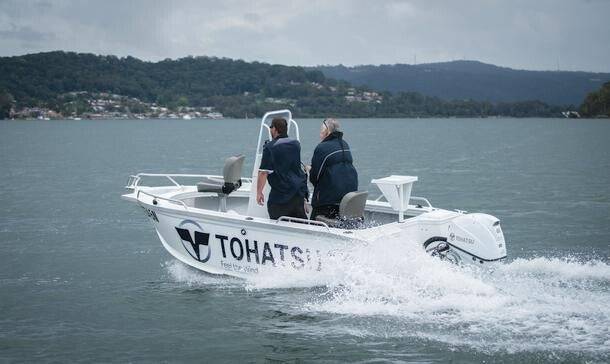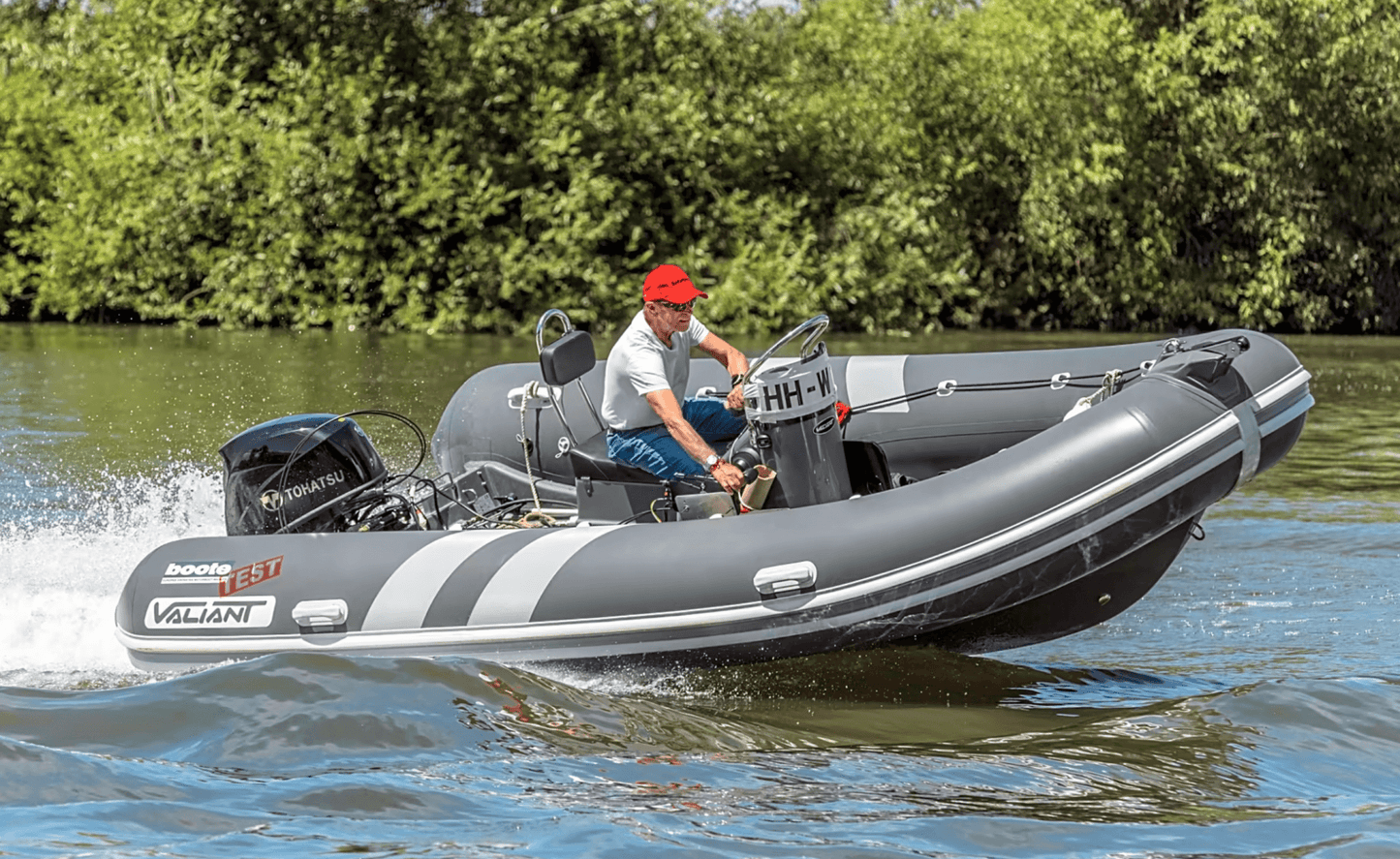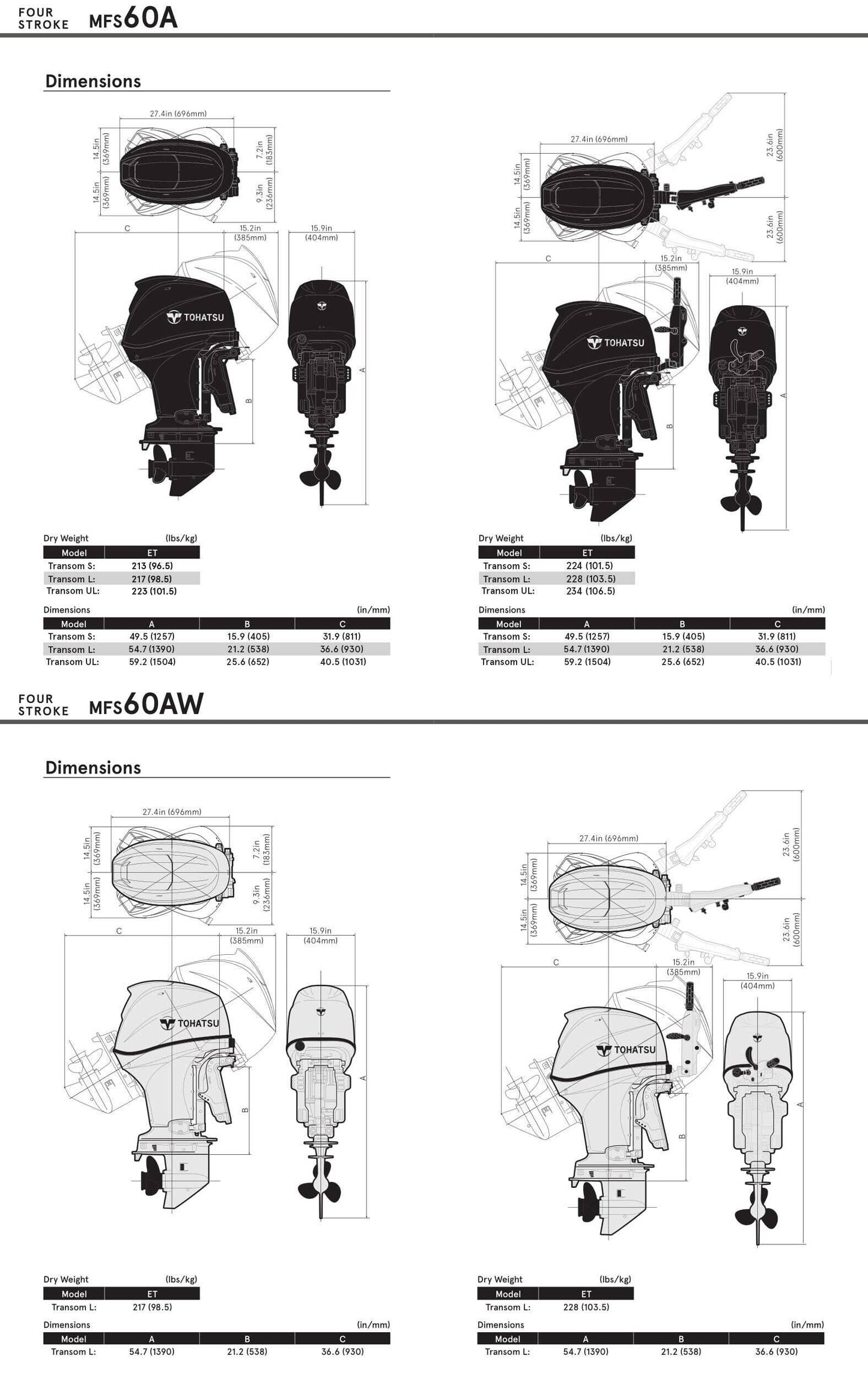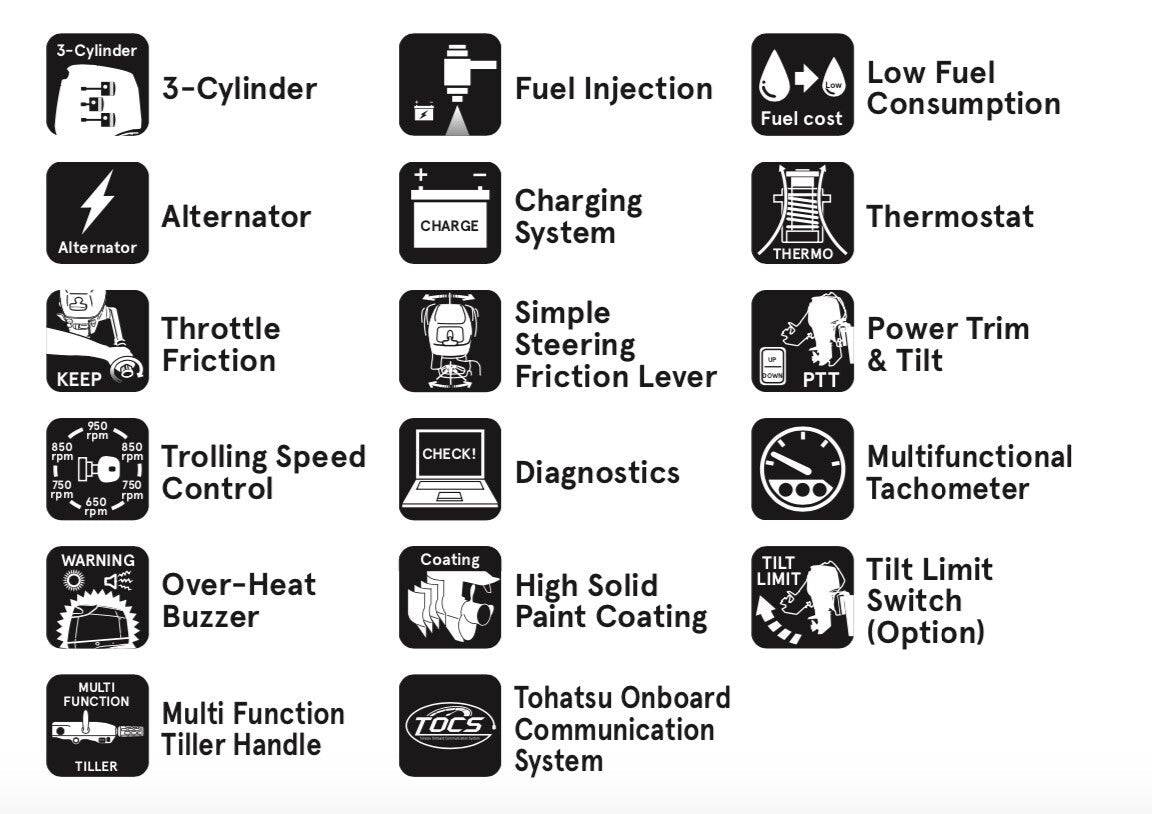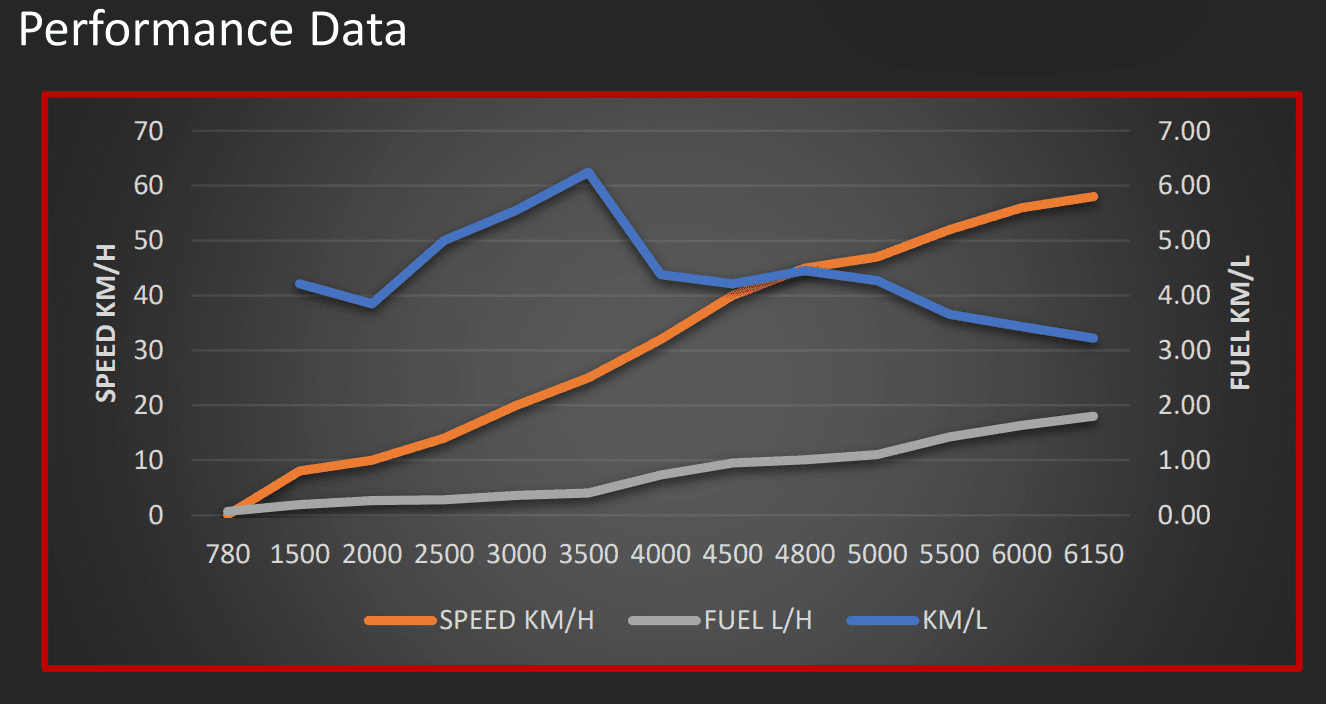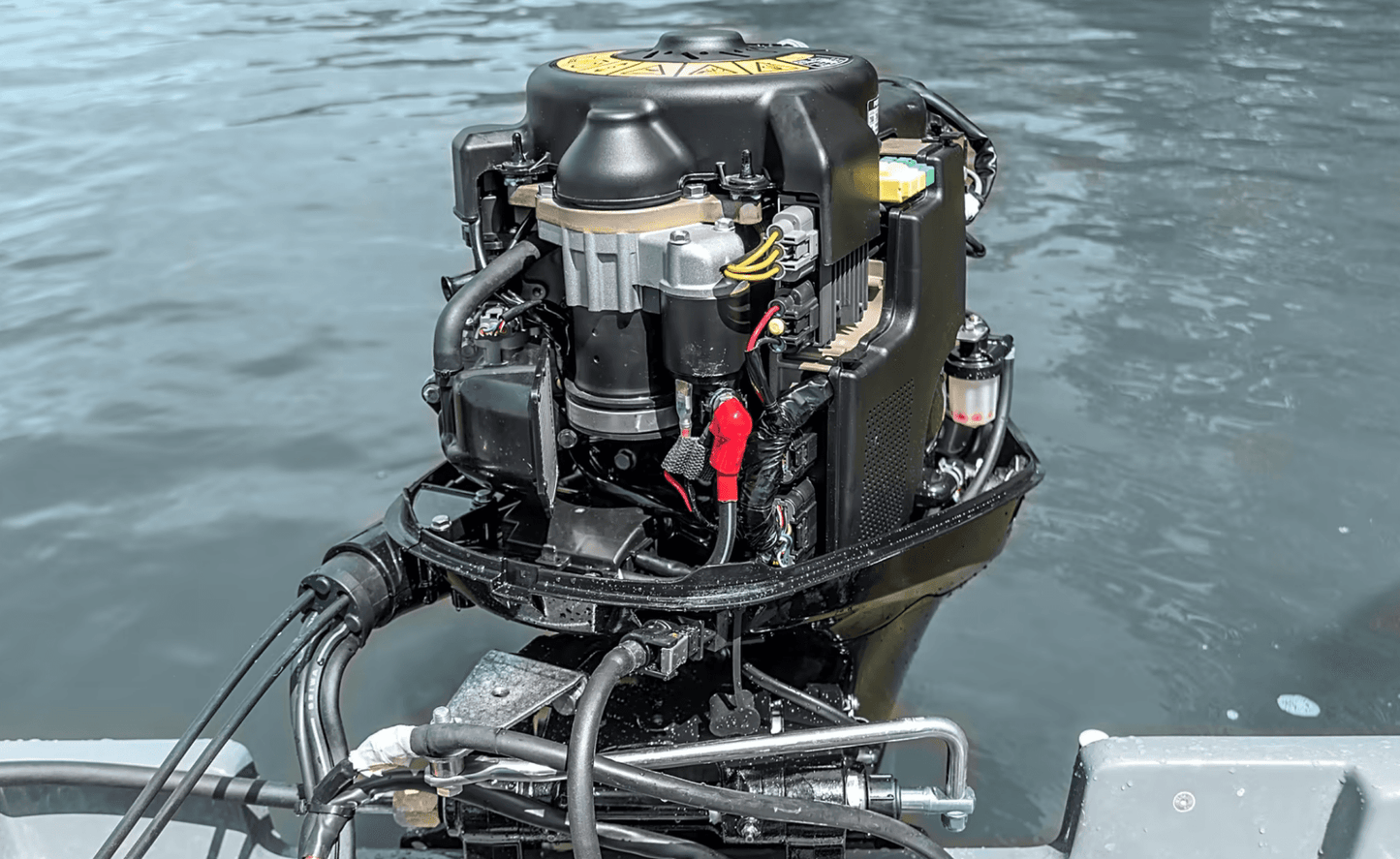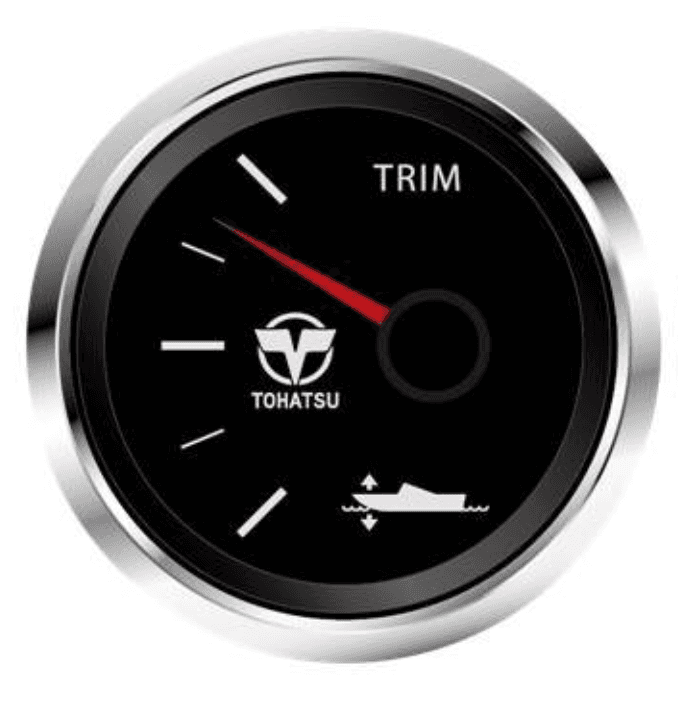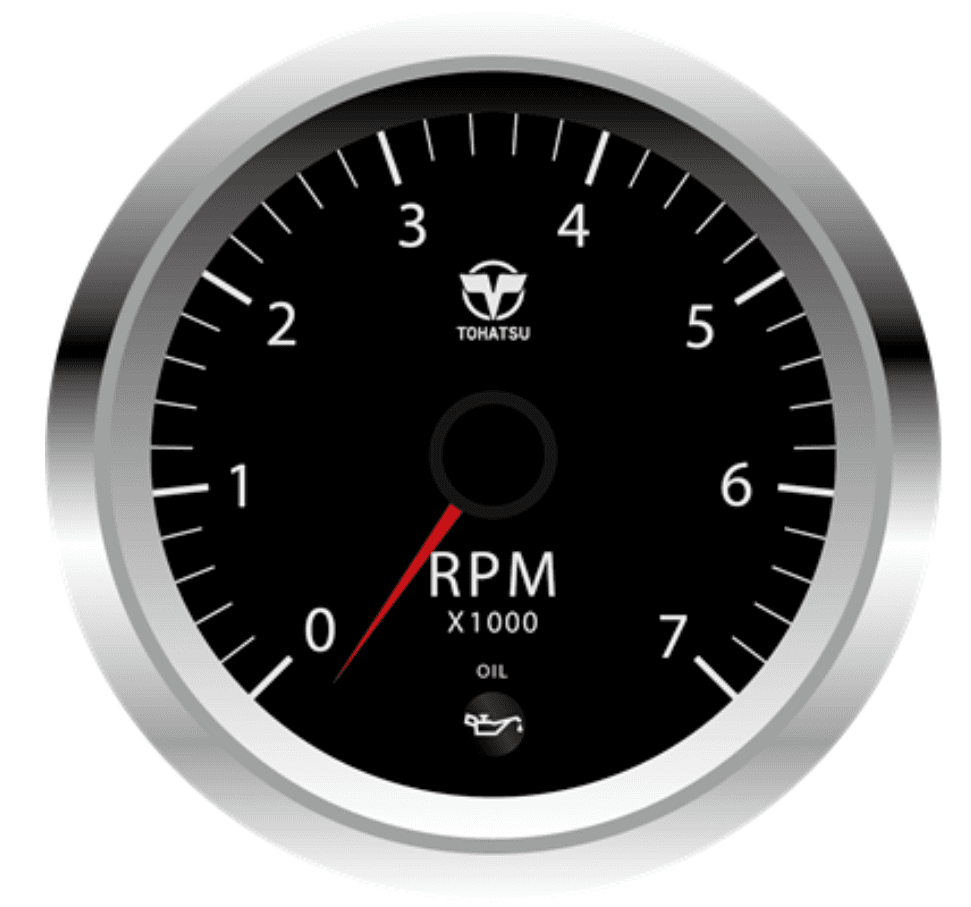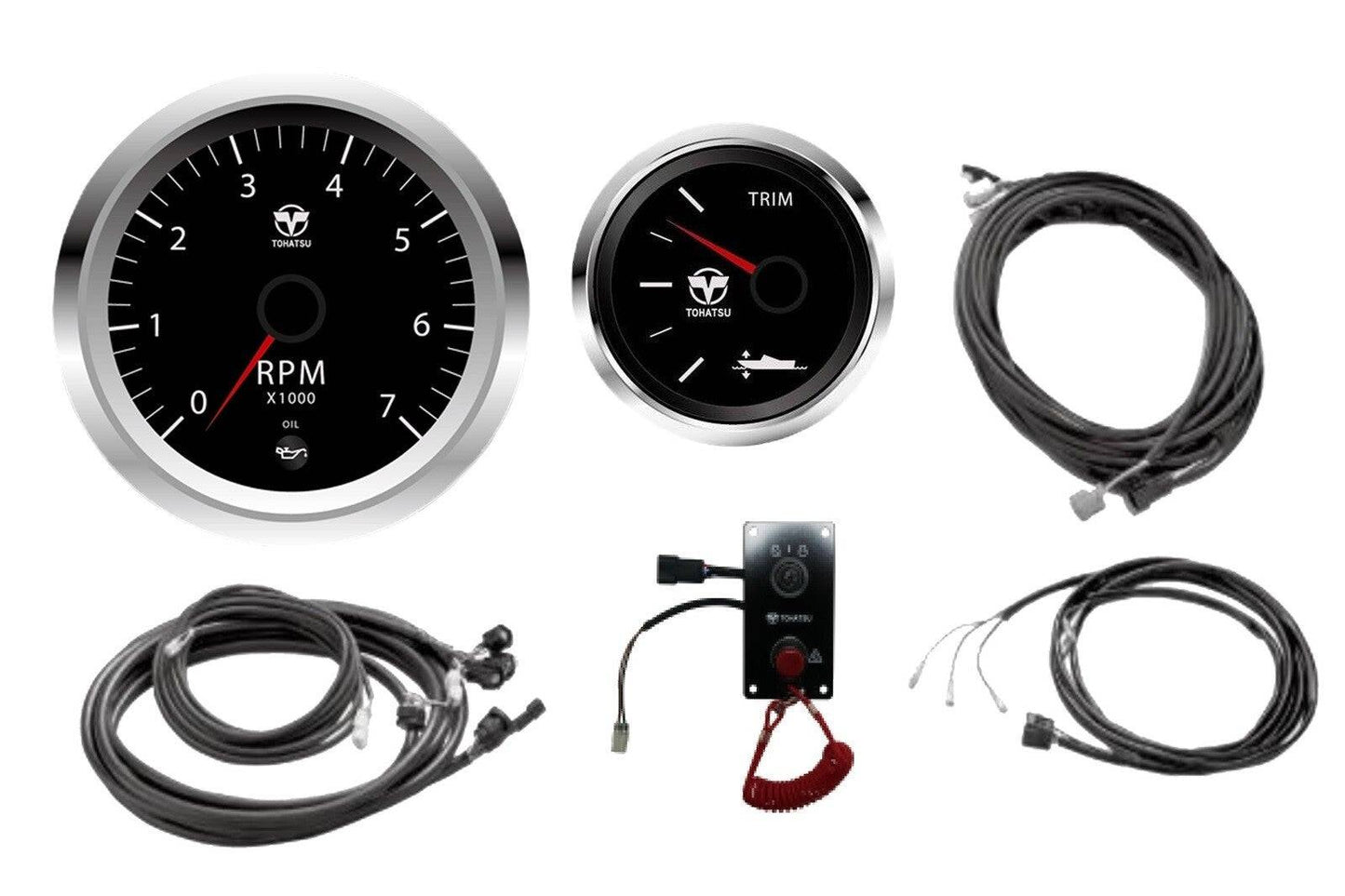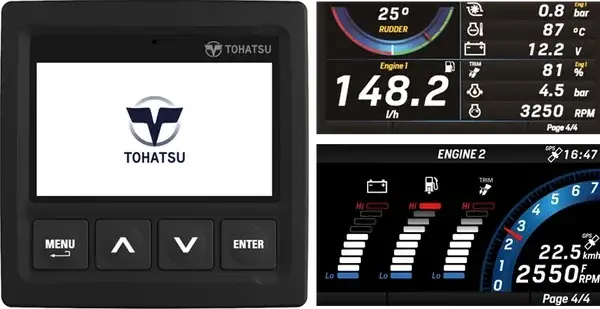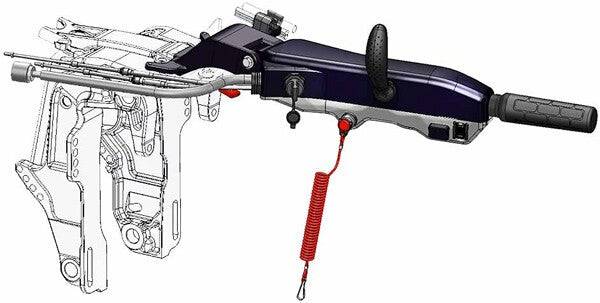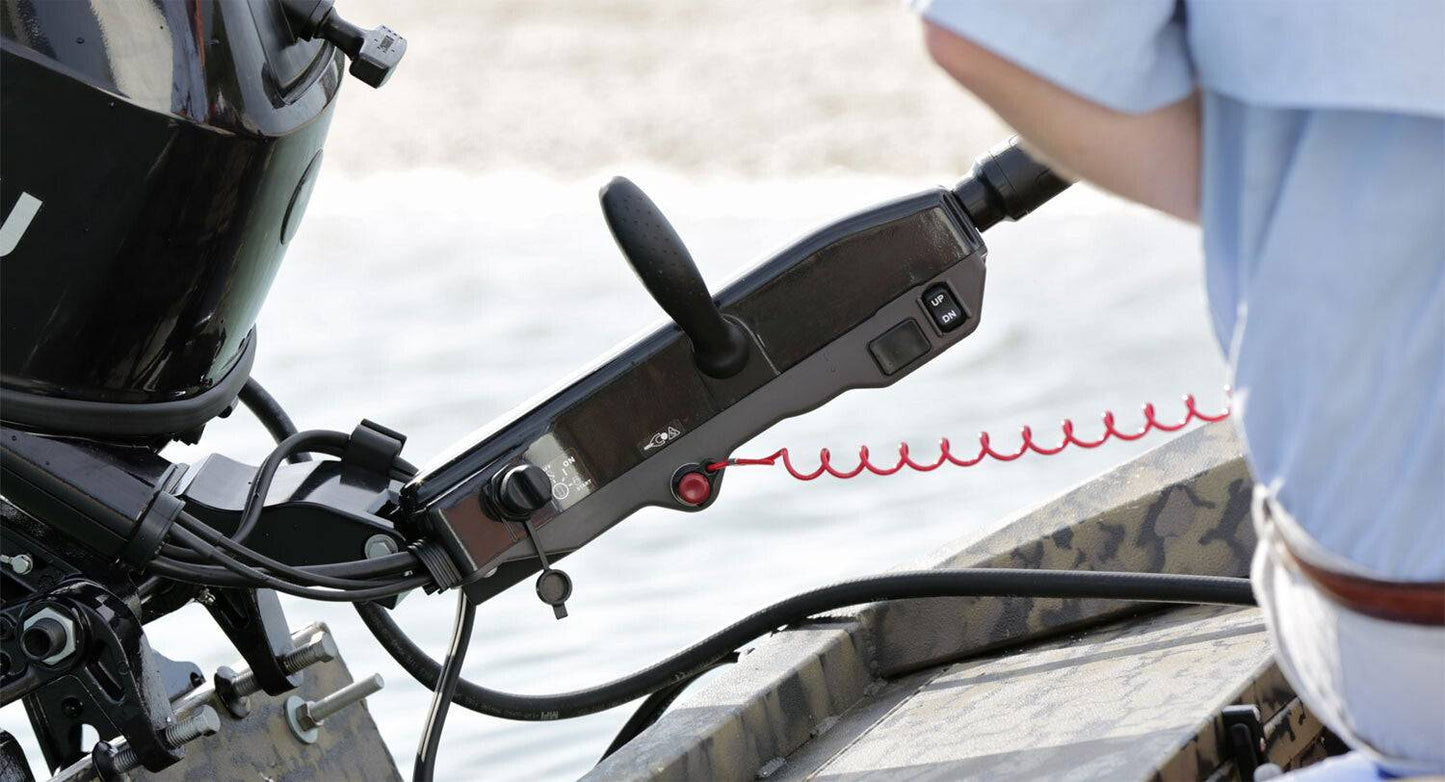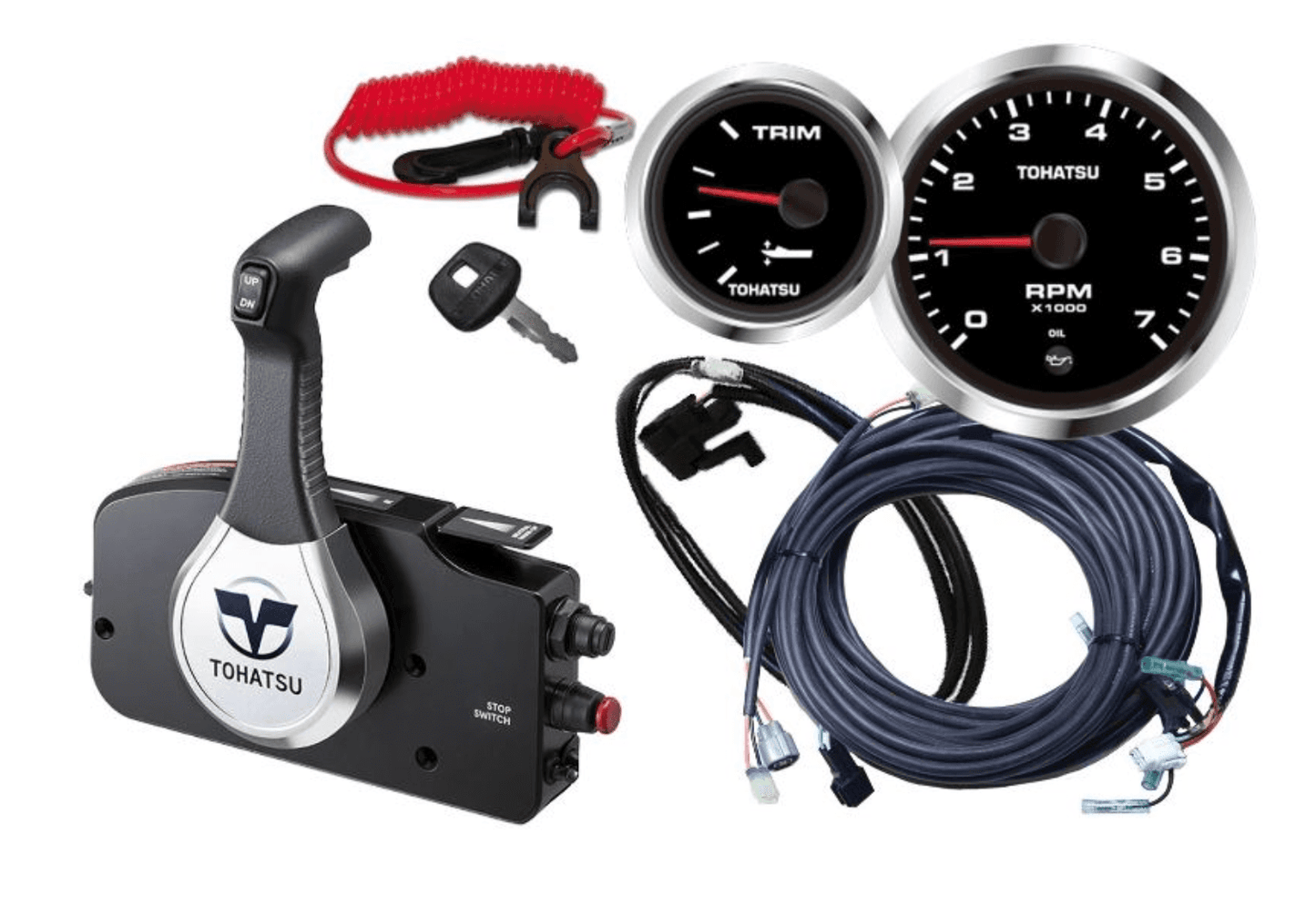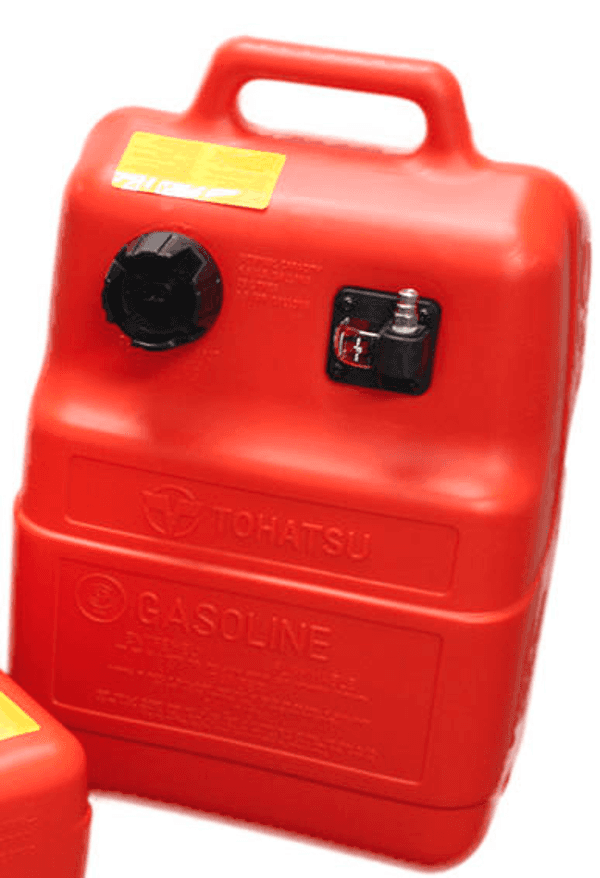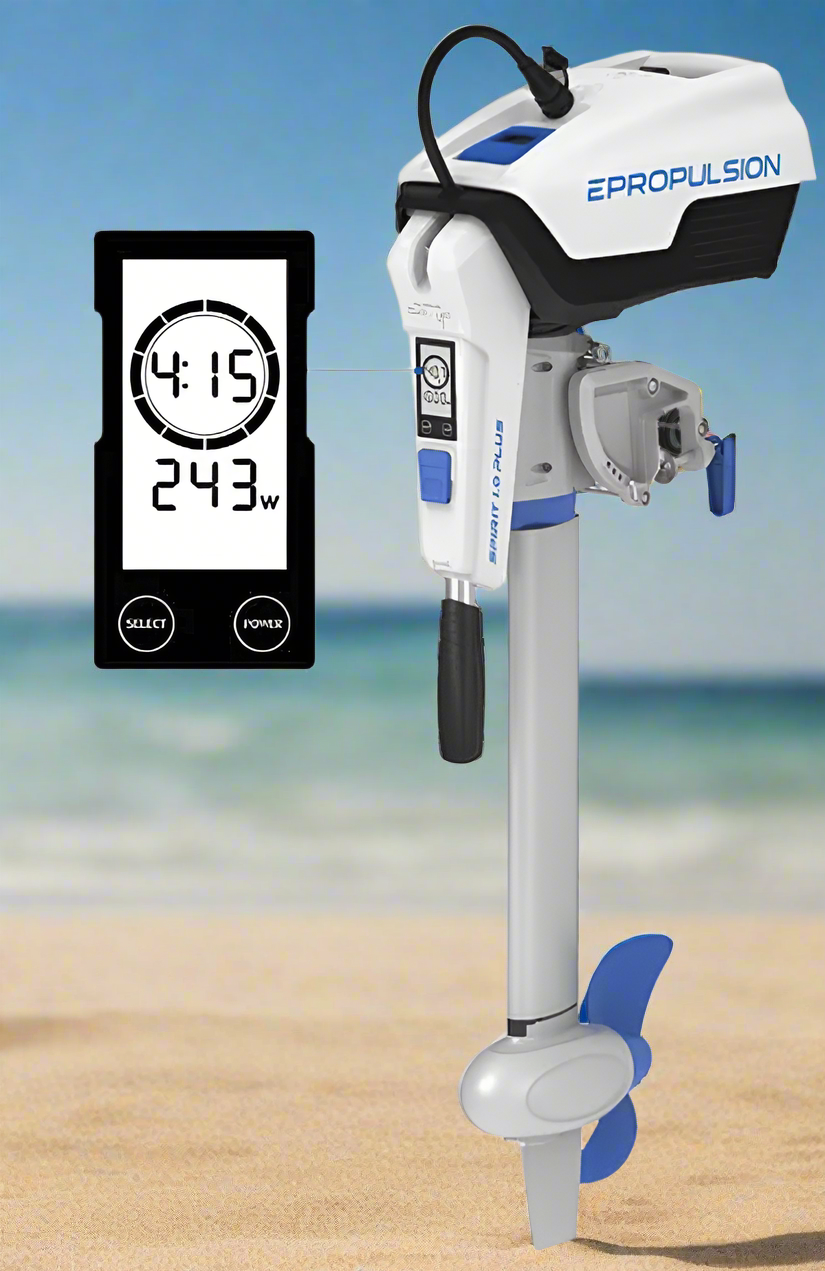Tohatsu 60 HP outboard motor MFS60A
Tohatsu 60 HP outboard motor MFS60A
Tohatsu MFS60A ETL 4-stroke outboard motor in stock!
With a sleek design, the new MFS60A 4-stroke outboard is built with new technologies and features. By utilizing proven technology such as electronic fuel injection (EFI), dual intake valves, anodized pistons, and a modified roller rocker arm, your time on the water will be equipped with smoother, faster acceleration.
This outboard motor is suitable for water sports; for water skiing, wakeboarding or wakefoiling (for boats with a speed from 20 kilometers per hour for beginners up to 35 kilometers per hour for advanced users).
A rule of thumb is that for fast boats, you need 1 hp for a total weight of 10 to 20 kilograms. Based on this, this outboard motor is suitable for a total weight of 600 to 1,200 kilograms.
For displacement boats, 1 hp per 150 to 200 kilograms is sufficient; then the engine is adequate for 9 to 12 tons of total weight.
-
Test report sailing test 1: Topcraft 565 : The test boat's well is equipped with a 60hp Tohatsu, a powerful three-cylinder gasoline engine. It's a new model introduced this year and is the lightest in its class, tipping the scales at 98.5 kilograms. This engine is also equipped with state-of-the-art features like EcoMo and Blast. These features make the engine run more efficiently without sacrificing power. It's a smooth, responsive engine that idles quietly and looks modern.
On this day with lots of waves and wind we note A top speed of 43 kilometers per hour . That's a good speed, but this tender is undoubtedly better suited as a displacement tender or a fast-sailing tender when conditions are optimal.
-
Test report Sailing test 2 Sailing test review by Boote-Magazine.de in 2020 comparison between Honda, Mercury, Suzuki, Yamaha, Selva und Tohatsu.
The slowest, Tohatsu's MFS 60, struggles to reach 60 km/h (37 mph). The Honda comes closest to the Mercury (67 km/h (42 mph)).
The sprinter's race is titled "Upside Down World." Simply the best, the Mercury lags behind in acceleration (0 to 30 and 0 to 50 km/h). Does the high engine mount, which allows for a slight airflow to the propeller, take its toll here? The winner is Tohatsu, that has no chance of top speed.
Conclusion: The search was for the first of equals. We found a performance class with virtually no significant differences in terms of quality, handling, and standard equipment – this is where the Selva and Yamaha score with a portable 25-liter tank. This is reflected in the price point, which falls somewhere between expensive (Yamaha) and inexpensive (Tohatsu), and in the test results. Its sprinter qualities, its weight, and the five-year warranty speak in favor of the Tohatsu.
The Honda The Tohatsu is the test winner, primarily due to its quiet motor. Therefore, the Tohatsu can be considered the motorcycle with the best price/quality ratio.
Tohatsu MFS 60 A The inexpensive lightweight from the Far East became the " sprinter king " in the test
-
Test report Sailing test 2 review 2020 Fishingworld.com.au
The Mad Dog Brute is available in center and side configurations. The test boat had a center console, a good fit for a boat like this, with plenty of room for fishermen and other passengers. Typical for a 16-foot center console, this boat offers great versatility.
Taking the boat to Broken Bay on a stormy day was a fantastic test, and the boat passed with flying colors. The Brute gave a fantastic account of itself as it sailed through oncoming swells at a moderate cruising speed of around 18 knots. The extra-high console offered me, the pilot, ample protection from spray, and I stayed completely dry.
The boat did about 30 knots at 6,000 RPM ( 56 kilometers per hour ), with a good cruising speed of 18 knots at 4,000 RPM. You could increase the engine power, but I thought this 60 hp was a good match for the 4.89 with two people aboard.
The MFS 60A meets many requirements for anyone looking for a 60-hp four-stroke. Weighing just 98.5 kg (212 lbs), the new engine is 15 percent lighter than Tohatsu's previously popular M60C two-stroke. That's impressive. It's also 7 kg (15 lbs) lighter than its closest competitor.
With the phasing out of old-technology two-stroke engines, Fisho no longer needs to rely on heavy or slow four-stroke engines. With models like these, the future looks bright for boaters!
The 3-cylinder 60 is very quiet, economical, powerful and environmentally friendly at idle and on the road.
Features include idle speed trolling control, simple freshwater flush system, multi-function tiller (EFTL), TOCS on-board communication connectivity (optional).
Optional: TOCS 4.3 inch LCD color display with information on:
- Engine speed
- Engine operating temperature
- Battery voltage
- Fuel consumption
- Tilt/trim meter*
- Total engine operating hours in hours
- Total fuel consumption
- Fuel tank level(s)
- Current consumption
- Course/speed
- Various warnings
- Self-diagnosis system
With NMEA2000 , J1939 CAN Bus and coupling.
It is also possible to order a package of original Tohatsu analog built-in gauges for the same price: tachometer, speedometer, hour meter, trim meter, voltmeter, and fuel gauge.
Tohatsu says the MFS60A retains many of the proven core values of the MFS40/50A. However, Tohatsu engineers have introduced several interesting "Simpliq technologies" in the new MFS60A, including: a three-valve intake, roller rocker arms for friction reduction, and anodizing along with a unique piston.
It's also a great looking bike and comes in aquamarine or beluga white.
Engines in the 60 hp range are a very popular size in Australia, fitting a category of boat we enjoy using. I have no doubt that the Tohatsu, with its lightweight design, fuel efficiency, quietness, and responsiveness, will offer excellent value for money.
-
Test report 3 sailing test review by tradeboat.com.au
The test was carried out using a Stessco Catcher 449 SC boat with a total weight of 600 kilograms including passengers.- At 1,100 rpm a speed of 4 kilometers per hour was achieved with a consumption of 2 liters per hour.
- At 3,000 rpm a speed of 20 kilometers per hour was achieved and a consumption of 5 liters per hour.
- At 4,000 rpm a speed of 30 kilometers per hour was achieved with a consumption of 8 liters per hour.
- At 6,150 rpm (full power) a speed of 59 kilometers per hour achieved and a consumption of 19 liters per hour. Source: Tohatsu.com.au.
When Tohatsu released its MFS 50A, it was one of the lightest outboards in its power class. But its homegrown 60 is only 1.5 kg heavier and a whopping 11.5 kg lighter than the Honda-produced BFT 60A it replaced. In fact, the MFS 60A is only 6 kg heavier than the old 798 cc twin-cylinder, oil-injected carbureted two-stroke Suzuki DT60C from 1983, an incredible achievement for a three-cylinder, four-stroke 60 with fuel injection.
But how Tohatsu achieved the 9.8 hp increase from the same displacement MFS 50A was surprisingly simple. Even more incredible, the MFS 60A outperforms its much larger displacement, four-cylinder, four-stroke 60A competitors.
Tohatsu was very clever in the way it designed its 60. Instead of increasing piston displacement, it increased airflow to the cylinders, effectively reducing the volume of the air intake manifold. The result was faster-flowing air. To promote faster flow, the throttle body's butterfly valve was thinned for less air disruption.
Two valves per cylinder weren't enough for this increased airflow, so Tohatsu added an additional intake valve and increased valve lift from 9–9.5 mm. Rollers were added to the rocker arms, which were driven by the single belt-driven overhead camshaft, to reduce friction and component wear. The squish area of the piston crowns was increased to raise the compression ratio. All these modifications improve performance without having to opt for a lighter plastic intake manifold, which can warp if the engine overheats.
Unlike the previous Honda-produced Tohatsu BFT 60A, the oxygen sensor in the exhaust system was removed due to reliability concerns. An oxygen sensor measures the density of the combusted air/fuel mixture and advances the ignition timing when using a higher-octane fuel, such as 95 RON premium unleaded. So, unlike the Honda engine, there's no point in using 95 RON when 91 can do a similar job. However, 95 is a denser fuel, has a longer shelf life, and you're less likely to notice it being contaminated with ethanol than 91 standard unleaded.
In all other respects, the 60 is identical to its 50 counterpart. The gearbox and gear ratio are the same, as is the 2.4-liter oil pan capacity. The voltage-regulated alternator produces up to 21A, four times more than the Honda-produced 60, but approximately 5A is used to run the engine management system and electronic fuel injection, which, quite reasonably, is still a single-point throttle body, not the heavier and more complex multi-point system used in most car engines.
Access to the Powerhead is excellent, with the engine oil sump dipstick on the starboard side and the filler cap on the port side, and the bowl-shaped fuel filter and canister oil filter are easily accessible. Nice touches include separate ignition coils and a protruding sump oil plug for draining engine oil without it dripping down the tail.
Anodes are placed above and below the anti-ventilation plate and are large enough to be effective.
If necessary, valve clearance is adjusted using a wrench and feeler gauge, not the complex bucket and shim system that requires removing the camshaft in DOHC competition with direct valve actuation, which in my opinion is simply cost-effective. Fortunately, Tohatsu followed Honda's lead and not its other Japanese competitors.
Maintenance intervals are every 100 hours of operation or annually after the first 20 hours or three months. However, if I was doing a lot of trolling, I would change the engine oil and filter every 50 hours or six months to prevent the crankcase oil from the combustion chamber's piston ring from diluting. Fresh oil and a new filter are cheap insurance against engine wear problems on the road.
The 60 can be flushed with fresh water without running the engine, but I recommend an occasional flush with sleeves to wash away aluminum chloride deposits around the cooling water impeller and thermostat.
ON THE WATER
The demo engine had clocked up about eight hours of runtime before I tested it, so it wasn't fully broken in, but enough to perform some limited Wide Open Throttle testing. Unfortunately, due to rather rough test conditions and the noise of the aluminum hull, I couldn't get accurate decibel or noise measurements. I was surprised that the standard alloy propeller was a perfect fit for the demo hull, a rare feat when it comes to propping engines over 40 hp.
The 60 started just as quickly and easily as the 50 and had similar vibration levels from trolling to WOT. Provided the anti-ventilation plate remained submerged, reverse power was good, useful for backing out of lean water. It handled the rather large Mad Dog 489 Brute center console better than I expected and was able to plane the hull well below where the maximum torque is developed. I've always believed that for good planing with fuel efficiency, plus reduced engine stress and wear, an engine must plane a hull at rpm below peak torque, and the 60 planed us at 1000 rpm below the torque peak. Even while cruising, it was close to its maximum engine efficiency band.
Due to tight turns with the leg shortened, there was no propeller ventilation, and the alloy propeller was a bit harder than I expected. In engines under 100 hp, alloy props are so good these days that stainless steel is rarely needed. Even at full power in a straight line with the tail trimmed well out, there was no sign of prop blowout. The standard power trim operated quickly and quietly.
What did surprise me was the engine's overall performance. Way back in 2004, I tested an early fuel-injected Yamaha F60C on a Horizon Sea Breeze 4750 bow rider; wielding a 13-inch-pitch alloy propeller (for a 1.85:1 gear ratio) and pushing a total of 800kg, the WOT average was 27kt (50km/h) at 5650rpm with 19.2 litres/h. I hadn't expected the MFS 60A to perform so well, but it left the Yamaha in its dust.
In fact, only the MFS 50A came close. On a Clark 435 center console I tested in 2014, swinging the same support and pushing a total of 750 kg, it averaged 30.5 knots and 16.8 l/h at 6300 rpm, just below the rev limiter. But the 489 Brute is a significantly larger hull compared to both the Clark and Horizon hulls.
THE CHANGE
Tohatsu has debunked the old adage "there's no substitute for displacement" when it comes to mid-range four-stroke outboards. Its lightweight 60-stroke design makes repowering easy, as it's suitable for a wide range of hulls.
-
More speeds
- With a Whaly 500 you can reach over 60 kilometers per hour.
- With a rubber boat, speeds of more than 60 kilometres per hour are achievable.
- With the Topcraft 565 with a boat weight of 600 kilograms, you can sail with a 60 hp outboard motor up to a top speed of more than 60 kilometers per hour.
- With the Riomar 515 sloop with a boat weight of 370 kilograms, you can sail with a 60 hp outboard motor up to a maximum speed of 55 kilometers per hour.
- With a Bayline 160 speedboat (600 kilograms net) you can sail up to 54 kilometers per hour.
- With the Oud Huijzer 600 tender with a boat weight of 600 kilograms, you can sail with a 60 hp outboard motor up to a maximum speed of 53 kilometers per hour.
- With the Nautilus 15 RIB with a boat weight of 366 kilograms, you can sail with a 60 hp outboard motor at a top speed of 53 kilometers per hour.
- With the Tridente 20 with a boat weight of 580 kilograms, you can sail with a 60 hp outboard motor at a top speed of 50 kilometers per hour.
- With a 5.5-metre speedboat weighing 1,000 kilograms, you can sail with a 60-hp outboard motor at a maximum speed of 50 kilometres per hour.
- With the Dutch Runabout 22 speedboat/sloop of 6.5 meters with 670 kilograms boat weight, you sail with a 60 hp outboard motor at a top speed of approximately 50 kilometers per hour.
- With the Elegance 635 tender you can sail with a 60 hp outboard motor at a top speed of 50 kilometers per hour.
- With the Chaloupe 610 tender with a boat weight of 500 kilograms, you can sail with a 60 hp outboard motor at a top speed of 45 to 50 kilometers per hour.
- With the Primeur 610 tender with a boat weight of 780 kilograms, you can sail with a 60 hp outboard motor at a top speed of 45 kilometers per hour.
- With the 4 Family 630 tender with a boat weight of 450 kilograms, you can sail with a 60 hp outboard motor at a top speed of 45 kilometers per hour.
- A Maxima 620 Tender (gross weight approximately 1,000 kilograms) sails at a top speed of approximately 45 kilometers per hour.
- With the Lago Amore 633 with a boat weight of 800 kilograms and 4 persons, you can sail with a 60 hp outboard motor up to a maximum speed of 42 kilometers per hour.
- With a Corsiva 565 with a boat weight of 480 kilograms, you can sail with a 60 hp outboard motor up to a maximum speed of 40 kilometers per hour.
- With an Oud Huijzer 616 Tendersloep 6 meters with 690 kilograms boat weight you sail with a 60 hp outboard motor. With 6 people you can reach 30 kilometers per hour.
- With the Lago Amore 606 Tendersloep with a boat weight of 700 kilograms and 3 persons you can sail with a 60 hp outboard motor up to a maximum speed of 36 kilometers per hour (increasable with propeller optimization).
SPECIFICATIONS
- Power 60 hp
- Lubrication 4-stroke
- Weight 110 kilograms
- Start Electric
- Control type Remote control or steering lever
- Gear lever Forward - Neutral - Backward
- Fuel system Injection
- Number of cylinders 3
- Cylinder capacity 866 cm3
- Maximum power 44 kW
- Full throttle working speed 5000-6000 revolutions per minute
- Bore x impact 70x75 mm
- Trim/tilt mode Powertrim - Manual trim/tilt
- Tail length L (20'' = 51 centimeters)
-
VERSION: ETL: E: electric start , T: remote control and power trim , L: Long tail or W: In Beluga White. Steering wheel controls are available with both monocable and hydraulic controls.
With power trim and tilt, you can optimize the engine's tilt angle at the touch of a button. The trim gauge lets you quickly see if the engine angle is set correctly. This results in faster acceleration, smoother, faster, more fuel-efficient, more stable, and, above all, safer riding. It's also handy for trailering. -
(W) EFTL tiller/tiller model with Big Multi Tiller B handle (see images). This gives you electric starting and power trim of the outboard motor, without the need for a remote steering function.
- Ergonomically designed shift lever.
- Longer Thottle handle with 110 degrees of rotation for maneuverability
- Throttle Friction function for fine-tuning the comfort of the tiller
- Steering Co-Pilot for steering wheel control.
- Warning lights, key switch and tilt and trim switch (in the handle) easily accessible.
- Available in the colour Aqua Blue Article number 3KYQ63000-7 or Belgua White Article number 3KYW63000-4. -
Inclusive :
-
Rigging cord kit B standard vertical mounting panel without remote control with tachometer, trim meter, wiring harness with ignition switch and dead man's switch, communication cable kit (part number 3YU-84556-1)
-
or on request Side mount kit B Side mounting switch box with mounting kit, tachometer, trim meter, wiring harness with ignition switch and dead man's switch, communication cable kit (part number 3UH-84555-1)
-
or on request Side mount kit B Side mounting switch box with mounting kit, tachometer, trim meter, wiring harness with ignition switch and dead man's switch, communication cable kit (part number 3UH-84555-1)
- screw/propeller (standard 11.1 diameter, 14 pitch, other pitches on request)
- 24 liter fuel tank.
-
Rigging cord kit B standard vertical mounting panel without remote control with tachometer, trim meter, wiring harness with ignition switch and dead man's switch, communication cable kit (part number 3YU-84556-1)
- Excludes : starter battery, engine oil and delivery inspection.
- Trim meter
The 2" diameter trim gauge displays the engine angle for optimal performance and efficiency. It features a domed lens to minimize glare in direct sunlight, a fog- and scratch-resistant coating, and a chrome bezel.
- Tachometer
The 7,000-rpm tachometer (10-centimeter diameter) has a chrome ring and is illuminated for clear visibility in the dark. It features a domed lens to minimize glare in direct sunlight and a fog- and scratch-resistant coating.
The tachometer informs about potential problems, such as low oil pressure, low battery and overheating, through the built-in warning lights.
Benefits of Tohatsu 60 hp 4-stroke
- The best power-to-displacement ratio in its class.
- The best power-to-weight ratio in its class.
- Sleek design with monochrome tilt lever
- SOHC with unique 9-valve design
- Excellent fuel economy. At full power, consumption is 19 liters per hour.
- Lightest weight in its class, only 98.5 kg.
High performance and easy operation
- Electronic fuel injection
- Digital CD ignition system for faster starting
- High output 21 amp dynamo
- New and improved gearbox with lower gear ratio for more torque at low revs
- Adjustable steering friction and trim tab for less steering effort
- Power trim & tilt
Basic principles for ease of use and reliability
- Through the prop exhaust for a quieter ride
- Built-in freshwater flushing system for easy routine flushing
- Variable idle speed control from 650 to 950 rpm
- A camshaft-driven trochoid oil pump ensures long life of critical engine components
- Stainless steel water pump housing liner for excellent durability
Warning & protection
- Low oil pressure warning (visual and audible)
- Overheating warning (visual and audible)
- Battery voltage warning (visual only)
- Start-in-gear protection for safer engine starting
- Safety lanyard (an essential protection feature that is standard on all Tohatsu outboard motors)
- Overspeed limiter
FEATURES
SOHC 9-valves and roller rocker arms
SOHC with unique 9-valve design with roller rocker arms ensures minimal friction and provides faster throttle response, more durable against wear.
Multifunction joystick is available on select models.
The multifunction tiller handle features an ergonomically designed shift lever for easy and convenient shifting and a longer throttle grip with 110 degrees of rotation for easier maneuvering. All controls on the new multifunction tiller are conveniently located on the handle for easy access and control. Specifically, the gear shift, throttle, trim switch, safety lanyard, TLDI® warning lights, and electric key switch are all integrated into the tiller handle.
Variable idle system
allows to adjust the towing speed (RPM) in four levels from 650 rpm to 950 rpm (100 rpm each) using the key switch.
Built-in freshwater flushing system
Standard built-in freshwater flushing system simplifies routine engine flushing.
Audiovisual warning system
The tachometer informs the operator of potential problems, such as low oil pressure, low battery, and overheating, through built-in warning lights. (For models equipped with a tachometer)
Trim meter
The 2" diameter trim gauge displays the engine angle for optimal performance and efficiency. It features a domed lens to minimize glare in direct sunlight, a fog- and scratch-resistant coating, and a chrome bezel.
Tachometer
The 7,000-rpm tachometer (10-centimeter diameter) has a chrome ring and is illuminated for clear visibility in the dark. It features a domed lens to minimize glare in direct sunlight and a fog- and scratch-resistant coating.
The tachometer informs the operator of potential problems, such as low oil pressure, low battery and overheating, through built-in warning lights.
THEREFORE TOHATSU
- Tohatsu, based in Japan, has been in business for over 100 years and produces more than 200,000 outboard motors annually. TOHATSU is the largest outboard motor manufacturer in the world.
- Tohatsu has over a 10 percent market share in the Netherlands and is growing fastest in the country. For models up to 30 hp, it already boasts a market share of over 20% !
-
Did you know that Mercury even has Tohatsu manufacture its outboard motors up to 30 hp? The only difference is the cowling and the price.
The Tohatsu BFT models from 150 hp are rebranded Hondas since 2014. So you get a reliable Honda engine for a Tohatsu price.
-
Tohatsu motors offer the highest quality and are lower priced than other premium brands. Tohatsu is also the only brand that produces exclusively outboard motors, so it's truly specialized.
- Tohatsu pays close attention to the appearance of its outboard motors, and this model reflects that. The look is rugged and robust. Under the sleekly streamlined hood, you'll find trusted Tohatsu technology, designed for years of boating enjoyment with minimal maintenance.
- The Tohatsu engine is user-friendly in every respect. For example, the oil filter is positioned so you can easily change it yourself. The generous oil reservoir provides optimal lubrication for your outboard motor. The proven Tohatsu electronic injection system ensures smooth starting and quick throttle response. The RPM is easily controlled.
-
Your newly purchased Tohatsu outboard motor comes with a full 5-year manufacturer's warranty .
-
Tohatsu always comes out well in comparison tests.
- Read the test reports for the 15 , 30 , and 60 hp engines, among others. Tohatsu is the price-performance winner according to Boote Testen.
- The ANWB 'Water Champion' also conducted an outboard motor test. The Tohatsu 6 hp came out as winner forward based on, among other things, weight, noise and ease of use. According to the ANWB, you can best buy a Tohatsu 6 HP outboard motor.
- Boote-Magazin.de also has the Tohatsu MFS115 A tested: impressive result Thanks to its best torque-to-weight ratio and higher top speed, the Tohatsu is also extremely fuel-efficient thanks to its small displacement.
- Most models are available from stock!
That's why Tohatsu is the best outboard motor.
Tohatsu pays close attention to the appearance of its outboard motors, and this model reflects that. The look is rugged and robust. Under the sleekly streamlined hood, you'll find trusted Tohatsu technology, designed for years of boating enjoyment with minimal maintenance. The motor is user-friendly in every way. For example, the oil filter is positioned so you can easily change it yourself. The generous oil reservoir provides optimal lubrication for your outboard motor. Thanks to the proven Tohatsu electronic injection system, your engine starts easily and delivers rapid throttle response. The RPM is easily controlled.
WARRANTY & DELIVERY TIME
Your newly purchased Tohatsu outboard motor comes with a full 5-year manufacturer's warranty . This gives you solid assurance of worry-free boating. You'll receive a warranty certificate and receipt with your purchase. Any technical defects that occur within the warranty period and are covered by the warranty terms will be repaired free of charge.
Low stock: 1 left
Couldn't load pickup availability
Share
